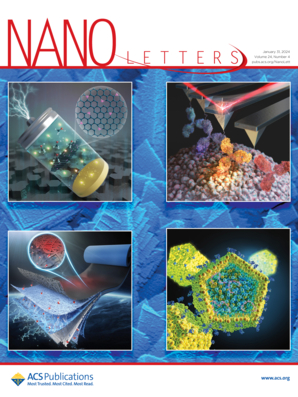量子自旋霍尔绝缘体TlX (X = As, Sb, Bi)的激子不稳定性。
IF 9.6
1区 材料科学
Q1 CHEMISTRY, MULTIDISCIPLINARY
引用次数: 0
摘要
激子绝缘体(EI)是一种长期寻找但异常稀缺的物质宏观量子相,仍然难以捉摸。我们提出量子自旋霍尔绝缘体(QSHIs)可以成为实现激子不稳定性的有希望的候选者。这是通过非典型逆准粒子(QP)对QSHIs的反转带进行校正来实现的,这将QP带隙(Eg)和激子结合能(Eb)的协同作用解耦。结合第一性原理计算和多体摄动理论,我们在QSHIs TlX (X = As, Sb, Bi)中验证了我们的建议,其中Eb超过QP Eg。与以往提出的由暗激子主导的EI状态形成鲜明对比的是,本研究的EI状态由具有负形成能和大振子强度的明亮激子组成,为探测EI提供了光学可达的特征。特别是,伴随非平凡带拓扑的相关EI的出现揭示了一种(明亮)拓扑EI的新范式。本文章由计算机程序翻译,如有差异,请以英文原文为准。
Excitonic Instability in Quantum Spin Hall Insulators TlX (X = As, Sb, Bi).
Excitonic insulator (EI), a long-sought yet exceptionally scarce macroscopic quantum phase of matter, has remained elusive. We propose that quantum spin Hall insulators (QSHIs) can be promising candidates for realizing excitonic instability. This is enabled by the atypical inverse quasiparticle (QP) correction to the inverted bands of QSHIs, which decouples the synergy of the QP band gap (Eg) and exciton binding energy (Eb). Combining first-principles calculations with many-body perturbation theory, we verify our proposal in the QSHIs TlX (X = As, Sb, Bi) with Eb exceeding the QP Eg. In stark contrast to the previously proposed EI dominated by dark excitons, the EI state in this study is constituted by bright excitons with negative formation energy and large oscillator strength, providing an optically accessible signature for detecting the EI. In particular, the emergence of correlated EI accompanied by nontrivial band topology unveils a novel paradigm of (bright) topological EI.
求助全文
通过发布文献求助,成功后即可免费获取论文全文。
去求助
来源期刊

Nano Letters
工程技术-材料科学:综合
CiteScore
16.80
自引率
2.80%
发文量
1182
审稿时长
1.4 months
期刊介绍:
Nano Letters serves as a dynamic platform for promptly disseminating original results in fundamental, applied, and emerging research across all facets of nanoscience and nanotechnology. A pivotal criterion for inclusion within Nano Letters is the convergence of at least two different areas or disciplines, ensuring a rich interdisciplinary scope. The journal is dedicated to fostering exploration in diverse areas, including:
- Experimental and theoretical findings on physical, chemical, and biological phenomena at the nanoscale
- Synthesis, characterization, and processing of organic, inorganic, polymer, and hybrid nanomaterials through physical, chemical, and biological methodologies
- Modeling and simulation of synthetic, assembly, and interaction processes
- Realization of integrated nanostructures and nano-engineered devices exhibiting advanced performance
- Applications of nanoscale materials in living and environmental systems
Nano Letters is committed to advancing and showcasing groundbreaking research that intersects various domains, fostering innovation and collaboration in the ever-evolving field of nanoscience and nanotechnology.
 求助内容:
求助内容: 应助结果提醒方式:
应助结果提醒方式:


